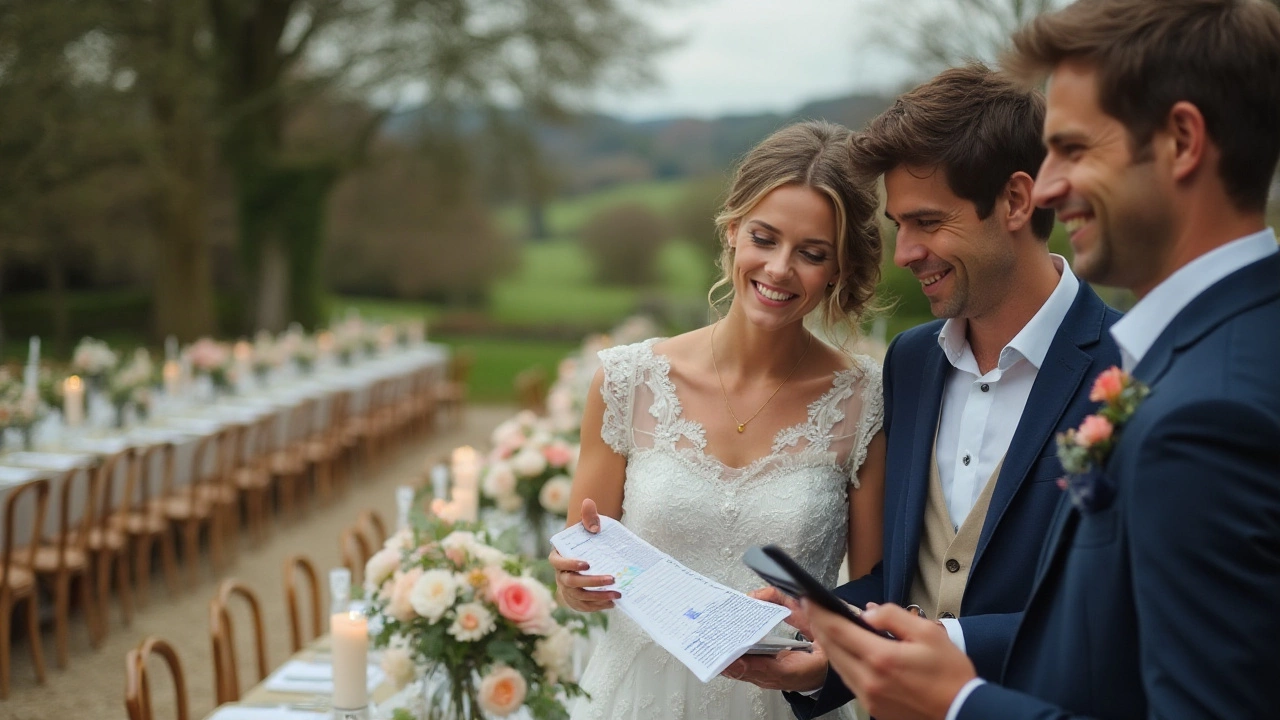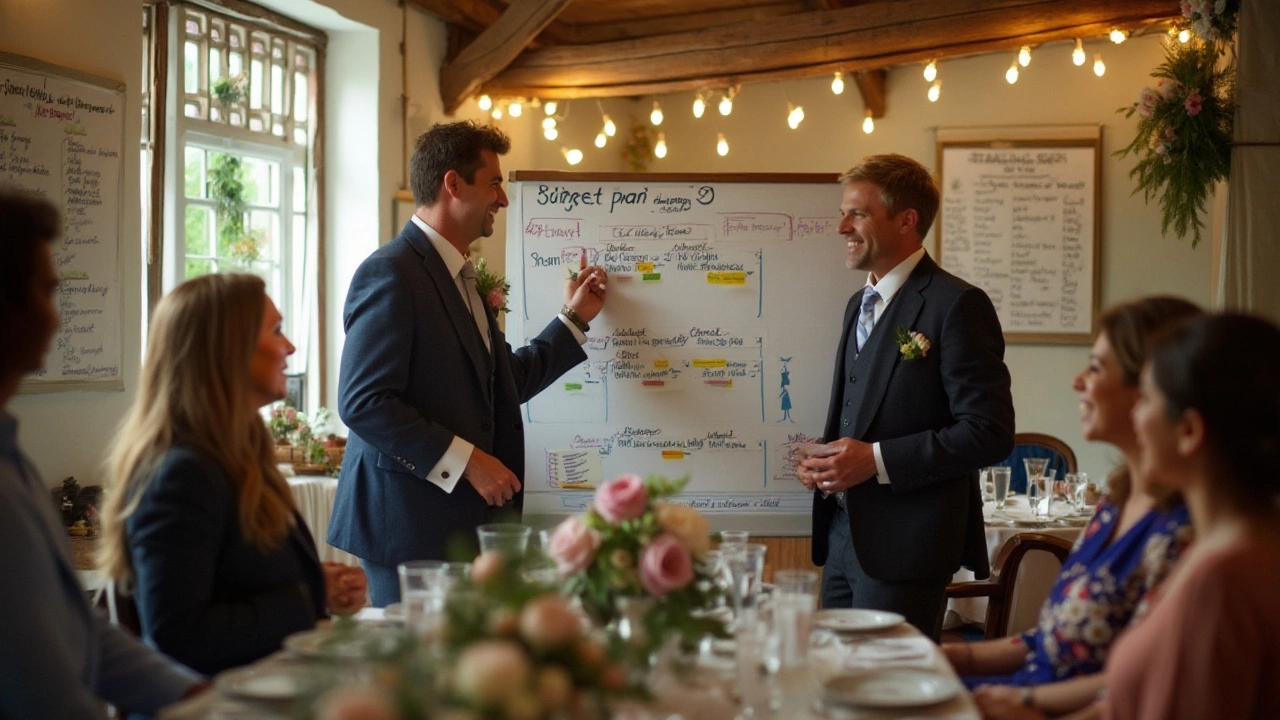Weddings are a beautiful celebration of love and commitment, a magical day that many dream about long before they say 'I do.' But behind the romance and the joy, there's a significant consideration that can loom over the festivities—cost. For many couples, figuring out how much money to save before planning a wedding can feel like a daunting task.
The truth is, there's no one-size-fits-all answer. Your wedding budget should be based on a diverse array of factors, such as your financial situation, your vision for the day, and the scale of the festivities. It's about finding a balance between what is feasible and what is meaningful to you and your partner.
This guide is designed to shed light on the essentials of wedding financial planning, offering insights and strategies to set a budget that aligns with your dreams without emptying your savings. Let's embark on this planning journey together and explore what it truly takes to not only have a wedding day that you will cherish forever but also one that doesn't leave you in financial distress.
- Understanding Wedding Costs
- Setting Your Wedding Budget
- Prioritizing Your Spendings
- Hidden Costs to Consider
- Tips for Saving Money
- Creating a Financial Timeline
Understanding Wedding Costs
Diving into the world of wedding planning can feel like opening a treasure chest, only to find it's filled with mysterious trinkets instead of precious jewels. The first mystery to unfold is understanding just what wedding expenses entail. The concept of a wedding budget can be elusive, with costs varying dramatically depending on whom you ask. From the enchanting venue to the photographers who will immortalize your moments, every element comes with a price tag that needs deciphering.
The scope of a wedding planning depends on various factors, including the location, the time of year, and the number of guests. As reported by The Knot, the average cost of a wedding in the United States was around $30,000 in the recent years preceding this article. This figure, however, fluctuates based on geographical location. For instance, a Manhattan wedding might soar well above this average, while a celebration in a less urban area could be more wallet-friendly. Importantly, these numbers only reflect averages; personal choices and creativity can significantly affect the final tally.
Breaking down the costs, the reception venue often tops the list, consuming about half of the wedding budget. With floral arrangements, catering, and entertainment adding layers, the expenses begin to stack up rapidly. Wedding attire, including the coveted gown, accounts for another significant portion, not to forget the rings symbolizing eternal love. A crucial yet sometimes overlooked cost is the unforeseen expenses—those delightful little surprises like cake-cutting fees or service charges that often creep up unexpectedly. Thus, creating a budget cushion of about 10% is often advised.
According to wedding planner extraordinaire David Tutera, "Budget is not a dirty word. It's the foundation of a celebration that enhances your story, not overshadows it."
It's vital to remember that no two weddings are alike; what matters most is aligning such costs with what truly matters to you and your partner. Comparing packages from vendors, negotiating prices, and considering off-peak seasons for discounted rates can all help in stretching a wedding budget. This reflects the idea that weddings are not merely about material splendor but about crafting a memory that reverberates with love and personal significance. Understanding these costs from the outset can ensure that planning your wedding becomes less about financial stress and more about joyful anticipation.
Setting Your Wedding Budget
When it comes to creating a wedding budget, the journey often begins with a deep dive into an open and honest conversation with your partner. It's essential to align on your financial capacities and expectations. Start by discussing how much each of you is comfortable contributing, any potential help from family, and the maximum you’re willing to spend. This might not be the most romantic part of the wedding planning process, but it's crucial for ensuring you're both on the same page and can enjoy your big day without monetary stress hanging over it.
Considering the complexities of wedding finances, an initial step is to research the standard wedding costs in your region. For instance, in the United States, as per a 2023 study by The Knot, the average wedding cost was around $30,000. However, this figure can vary greatly depending on your location, guest count, and the type of wedding you're envisioning. Having a ballpark figure helps in understanding whether your circumstances and expectations align realistically.
Identify Your Priorities
Every couple has different components that matter most to them; it might be the venue, the dress, the catering, or perhaps the entertainment. Identify these priorities early on, as these will be the areas where you might choose to allocate a larger part of your wedding budget. This doesn’t mean ignoring the other components completely, but it helps in making informed compromises down the line. To quote famed wedding planner David Tutera,"Your wedding day should be a reflection of who you are, not a collection of everything you've ever seen."Understanding your core priorities can guide you in steering your spending towards what truly matters for your wedding day.
Budget Breakdown Strategy
It's beneficial to break down your budget into categories to manage your finances better. Typically, couples allocate about 40% of their budget to the venue and catering, 15% to photography and videography, 10% to attire, 10% to music, and the remaining 25% to flowers, decorations, cake, transportation, and miscellaneous expenses. Consider creating an emergency fund within your budget, about 5% of the total, to cover unexpected expenses that may arise. This foresight can prevent last-minute financial anxiety and ensure you're prepared for surprise costs.Tracking and Adjusting
Once your wedding budget is established, the key is diligently tracking every expense. Utilizing budget tracking apps can simplify this process, helping you monitor expenditures and adjust as needed. Remember, flexibility is critical; as plans evolve, so too might your budget. Adjustments are part of the game, as long as they are handled with care and communication remains open. It's about crafting a day that's uniquely yours while staying financially responsible.
Prioritizing Your Spendings
When it comes to wedding planning, setting clear priorities is crucial to ensuring you're allocating resources effectively and making the most out of your budget. The very first step in prioritizing your spendings involves sitting down with your fiancé and having an open discussion about what aspects of the wedding are most important to you both. Perhaps you dream of an extravagant venue with breathtaking views, or maybe you want to splurge on a five-tier wedding cake that becomes the talk of the town. Determining these priorities will serve as your compass, guiding all financial decisions that follow.
Once you know what you value most, it’s time to reflect these desires in your budget. Create a list of wedding elements and rank them in order of importance. Don’t hesitate to allocate a more significant portion of your budget to top-tier items. Many wedding planners suggest focusing on three key areas that bring personal joy or hold sentimental value. For some, this might mean spending extra on professional photography to capture irreplaceable memories, while for others, it might mean investing in live entertainment to keep the dance floor alive all night.
"A memorable wedding doesn’t have to break the bank. It's about crafting an experience that reflects who you are as a couple," says acclaimed wedding planner Sarah Haywood.Now, don't overlook the smaller details. Things like personalized party favors might seem essential at first glance but could be scaled back or removed if they don't add significant value to your day. Keep a keen eye on hidden costs like transportation or late-stage alterations that can unexpectedly inflate your expenses. Keep some margin within your budget for any last-minute changes or upgrades you might wish to make.
It is worth understanding the value each area brings to your wedding budget. Consider using an approach where you predict the emotional return on investment for each element. For instance, you may find that having a live band instead of a DJ provides a unique ambiance that’s worth the extra dollars. Don’t underestimate the impact of experience over aesthetics in shaping the joy of your day. Look into how you can maximize spendings by pooling resources from family contributions, which can often cover certain prioritized areas without strain. Keep track of all allocations using digital tools or spreadsheets that allow for easier adjustments.
Strategic Saving Tips
With established priorities, focus on strategic savings. Look for opportunities like off-peak season discounts on venues or combine dress shopping with holiday sales. Consider sourcing decor from local artisans who might offer better prices than national brands. Use your network and seek recommendations for vendors who come highly praised yet priced reasonably. Remember, creativity often beats cost when focusing on aspects highly personal to you and your partner. And never underestimate the value of negotiation.Don’t ignore the power of having a bit of DIY in your wedding budget. Making centerpieces or invitations can add personal charm and cut down costs significantly. Be mindful of the mix between cost-saving techniques and ensuring quality experiences for you and your guests. Avoid compromising too much on safety, comfort, or any factors pivotal to the wedding’s success. Through thoughtful prioritizing and strategic spending, you will not only manage expenses wisely but also ensure a wedding that truly embraces your shared vision.
Hidden Costs to Consider
Planning a wedding can be an exhilarating experience, yet it's often coupled with unexpected expenses that can catch you off guard. The dreamy visions that capture your imagination are beautiful, but let's look a bit deeper into the unseen expenses that could inflate your wedding budget beyond what you initially anticipated. Understanding these costs can transform your planning process from a financial nightmare into a harmonious melody of love and joy. Transportation for guests is a classic example of an overlooked expense. Couples envision the perfect venue but forget that their guests might need a way to get there. Hiring shuttles or arranging car services might seem minor, but the costs can add up quickly when you factor in back-and-forth trips and waiting times.
Flowers bring ethereal beauty to a celebration, yet their costs can be more than just an aesthetic concern. It's not only about adorning your aisle with blossoms; it's also about the labor involved in arranging them. Talk to a florist about the entire package, including setup and breakdown fees. Some couples are surprised to find that labor can often match the cost of the flowers themselves. And don't forget that seasonal blooms could hike up the price if they're not readily available. Let's not overlook attire alterations too. Your dream dress or tux might come at a certain price, but the fitting fees can sneak up, especially when multiple adjustments are needed to achieve that perfect fit. Always factor in the possibility of needing last-minute adjustments as the day draws closer.
An often ignored financial aspect is the price of stationery accessories. While couples focus heavily on snail-mailed invitations, the additional items such as menus, escort cards, and thank you cards can stretch your wedding planning expenses. There's an artistry to these tangible pieces that goes beyond the initial perception of their simplicity. Some couples seek custom designs that tell their story, which can be beautiful but costly if not planned for in advance. "Remember, your paper suites are the tangible memories your guests take home," advises wedding planner Grace Atwood, highlighting the often underestimated importance of quality stationery.'; } ?> Even with careful budget management, couples sometimes forget about taxes and gratuities. A delightful meal and attentive service can define a wedding experience, but it's crucial not to overlook the taxes that can amplify your catering costs by a significant percentage. Be prepared for these charges alongside standard fees for waitstaff, bartenders, and other onsite professionals.
It’s equally essential to consider the impact of overtime costs. Venue rentals usually come with a defined time frame. If your celebration runs longer than expected, additional hours can be charged at premium rates, encompassing everything from the space itself to the employed staff. Discuss these possibilities with your venue coordinator to anticipate any necessary, yet often neglected, fees. Something as straightforward as permits can become unexpectedly costly, too. A stunning venue that possesses a unique character may require permits for amplified music, special lighting, or even alcohol service. Proactively researching these aspects will save you from last-minute scrambles.
Saving money occasionally includes the need to pay extra money for inevitable tasks such as cleaning services. At times, venues require security deposits that cover post-event cleanup, ensuring the space is left as pristine as it was found. However, these deposits might not be refunded if additional cleaning is required. Hiring professional cleaners might become necessary, implying additional expenses you hadn't originally tallied. Unexpected costs can sometimes feel like they take away from the magic, but with conscious planning and a detailed approach, you can control your wedding cost and preserve the enchantment of the day.
| Hidden Cost | Average Additional Cost |
|---|---|
| Guest Transportation | $500 - $1,500 |
| Flower Labor | $200 - $1,000 |
| Stationery Extras | $300 - $800 |
| Venue Overtime | $300 - $1,000 per hour |
| Permits and Taxes | 5% - 15% of total costs |
These hidden costs often reflect the fine details that make your wedding day special; however, being aware of them means taking proactive steps toward an effective wedding budget. Your day deserves to be celebrated for its love and commitment, not marred by unexpected surprises. As you move forward in your journey, embrace the planning process with an informed eye and unwavering enthusiasm.

Tips for Saving Money
When it comes to planning the finances for your wedding, being mindful of where you can cut costs without sacrificing your vision is crucial. There are numerous strategies and clever hacks to trim the expenses down, allowing you to save money without compromising the magic of your big day. One of the first steps is to clearly outline your wedding budget and identify what elements matter most to you and your partner. Perhaps a splendid venue tops your list, or maybe it's an unforgettable culinary experience. By prioritizing your spendings, you can ensure that funds go to what holds the most significance.
A savvy approach to keep costs in check is to deeply explore your network of friends and family. Often, there are talented individuals within your circle who can lend their skills, whether it be photography, music, or floral arrangements. Not only does this offer a personal touch to your day, but it might also come at a fraction of the cost you'd typically invest with professionals. This tactic has become increasingly popular among newlyweds who see it as an opportunity to involve loved ones more intimately. As Jane Bryan, a well-reputed wedding planner, once mentioned,
"Incorporating talents from within your circle crafts a more personalized wedding experience, often at no additional expense."
Consider choosing a non-conventional time or day for your wedding planning. Venues and vendors often charge premiums for Saturdays during the popular wedding months. Opting for a Friday evening, Sunday afternoon, or even an off-season month can often save substantial amounts. Additionally, keep an eye on minimizing decorations by emphasizing venues that come naturally adorned, be it through captivating architecture or beautiful landscapes. This can slash the costs further, allowing you to spend money elsewhere, perhaps on unique invitations or a memorable honeymoon getaway.
Crafting a Budget-Friendly Wedding
DIY projects have taken the planning world by storm, offering significant savings potential. Creating your own centerpieces, invitations, and favors not only can save money but often infuse your affair with heartfelt and authentic charm. Assemble a creative team from among your bridesmaids or close friends and have fun crafting over brunches or gatherings. Online tutorials are abundant, providing step-by-step guidance to even the least crafty among us. Make sure to also consider a digital route for certain elements. For instance, sending digital invitations can dramatically cut printing and postage costs, directing those savings towards vendor essentials.
Lastly, always be willing to negotiate. Vendors expect a bit of haggling and often have room for flexibility. Do your research, bring up competitive pricing, and see if a better deal can be worked out. Couples are often surprised at how much savings 'just asking' can bring. Remember to read contracts carefully to ensure no hidden fees pop up. This careful discernment ensures that you are only paying for services and products that truly enhance your celebration. Data collected from wedding trends indicate that the average couple can save up to 25% through effective negotiation.
Creating a Financial Timeline
Crafting a thoughtful financial timeline is a critical element in the journey of wedding planning. It’s not just about setting a wedding budget; it's about methodically outlining when and how expenses will occur. This ensures you manage your finances with foresight, allowing you ample time to gather or allocate funds that align with your special day. Starting this process early means fewer financial surprises and more control over your expenditures. Begin by listing out all your anticipated costs, from the venue to the smallest detail, and then establish deadlines for each. This meticulous approach can keep financial stress at bay and keep your wedding planning experience joyous and enjoyable.
The first stage usually involves setting deposits for venues and major vendors. These are typically required soon after booking, often 12 to 18 months before the wedding date. It's crucial to have your priorities set because these decisions can lock in a significant portion of your wedding planning budget early on. A wise approach is to have a separate fund or savings account dedicated to wedding expenses. This can help you track spending meticulously and ensure you don't dip into other savings. As your date approaches, stagger payments to make deposits more manageable; spreading out costs prevents a large outlay at any one time.
Planning Down Payments
Once you've tackled the initial phase of major vendor bookings, the next challenge is managing the interim period flux. About six to nine months before your wedding, is typically a time when you’ll finalize details for elements like the dress, accompaniments, the florists, or perhaps travel arrangements if you're planning a destination wedding. This period is often where mid-sized payments come into play. Consider planning out savings goals to hit these deadlines without resorting to credit, which could lead to post-wedding debt. By keeping these installments aligned with your paychecks, you can make the process smoother and less taxing on your household budget.
One effective strategy many wedding planners recommend is using a visual timeline or financial calendar. This tool enables you to plot check due dates, saving milestones and track cumulative costs in a more intuitive manner. When you spread expenses on a calendar, you have an at-a-glance view that can facilitate adjustments, allowing you to strategically advance or delay purchases to match cash flow fluctuations.
Final Payments and Emergency Funds
With the wedding day fast approaching, final payments for catering, venue, and decoration services will often fall due about a month to two before the big day. Keeping an emergency fund for unexpected costs is not just smart; it's essential. Approximately 15% of the budget should be reserved for these surprises to manage any last-minute changes without stress. Vendors sometimes offer discounts for early payments, so inquiring about this might lower costs. One couple shared, “By paying our photographer early, we saved enough to upgrade our floral arrangements significantly.”
The Knot advises, "Consider padding your final costs by 5 to 10% to have a buffer for overlooked expenditures."
Remember, this isn't just another financial task; it's the foundation of a memorable event. A well-organized financial timeline reflects a strategic approach that respects both your dreams and your wallet. This holistic perspective ensures your day is filled with happiness and cherished forever.

